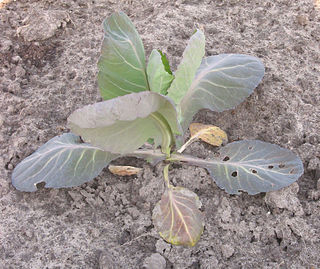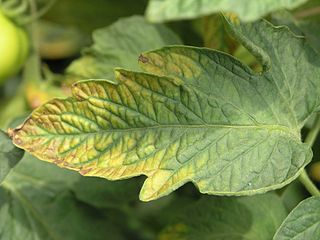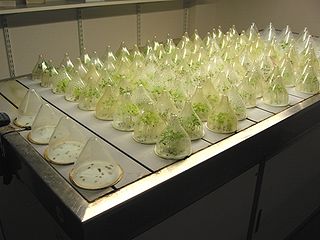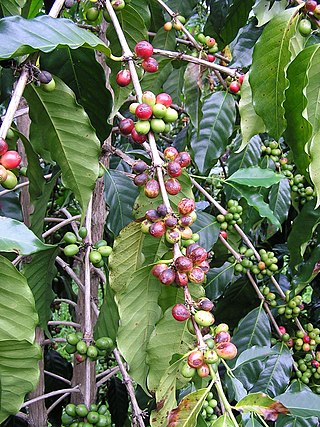
Plant pathology or phytopathology is the scientific study of plant diseases caused by pathogens and environmental conditions. Plant pathology involves the study of pathogen identification, disease etiology, disease cycles, economic impact, plant disease epidemiology, plant disease resistance, how plant diseases affect humans and animals, pathosystem genetics, and management of plant diseases.

Calcium (Ca) deficiency is a plant disorder that can be caused by insufficient level of biologically available calcium in the growing medium, but is more frequently a product of low transpiration of the whole plant or more commonly the affected tissue. Plants are susceptible to such localized calcium deficiencies in low or non-transpiring tissues because calcium is not transported in the phloem. This may be due to water shortages, which slow the transportation of calcium to the plant, poor uptake of calcium through the stem, or too much nitrogen in the soil.

Nitrogen deficiency is a deficiency of nitrogen in plants. This can occur when organic matter with high carbon content, such as sawdust, is added to soil. Soil organisms use any nitrogen available to break down carbon sources, making nitrogen unavailable to plants. This is known as "robbing" the soil of nitrogen. All vegetables apart from nitrogen fixing legumes are prone to this disorder.

Potassium deficiency, also known as potash deficiency, is a plant disorder that is most common on light, sandy soils, because potassium ions (K+) are highly soluble and will easily leach from soils without colloids. Potassium deficiency is also common in chalky or peaty soils with a low clay content. It is also found on heavy clays with a poor structure.

The following outline is provided as an overview of and topical guide to organic gardening and farming:

Plant nutrition is the study of the chemical elements and compounds necessary for plant growth and reproduction, plant metabolism and their external supply. In its absence the plant is unable to complete a normal life cycle, or that the element is part of some essential plant constituent or metabolite. This is in accordance with Justus von Liebig's law of the minimum. The total essential plant nutrients include seventeen different elements: carbon, oxygen and hydrogen which are absorbed from the air, whereas other nutrients including nitrogen are typically obtained from the soil.

Plant physiology is a subdiscipline of botany concerned with the functioning, or physiology, of plants.

Worldwide more human beings gain their livelihood from agriculture than any other endeavor; the majority are self-employed subsistence farmers living in the tropics. While growing food for local consumption is the core of tropical agriculture, cash crops are also included in the definition.

Ceratocystis fimbriata is a fungus and a plant pathogen, attacking such diverse plants as the sweet potato and the tapping panels of the Para rubber tree. It is a diverse species that attacks a wide variety of annual and perennial plants. There are several host-specialized strains, some of which, such as Ceratocystis platani that attacks plane trees, are now described as distinct species.

Mycosphaerella coffeicola is a sexually reproducing fungal plant pathogen. It is most commonly referred to as the asexual organism Cercospora coffeicola.

Rotylenchulus reniformis, the reniform nematode, is a species of parasitic nematode of plants with a worldwide distribution in the tropical and subtropical regions.

Pratylenchus penetrans is a species of nematode in the genus Pratylenchus, the lesion nematodes. It occurs in temperate regions worldwide, regions between the subtropics and the polar circles. It is an animal that inhabits the roots of a wide variety of plants and results in necrotic lesions on the roots. Symptoms of P. penetrans make it hard to distinguish from other plant pathogens; only an assay of soil can conclusively diagnose a nematode problem in the field. P. penetrans is physically very similar to other nematode species, but is characterized by its highly distinctive mouthpiece. P. penetrans uses its highly modified mouth organs to rupture the outer surface of subterranean plant root structures. It will then enter into the root interior and feed on the plant tissue inside. P. penetrans is considered to be a crop parasite and farmers will often treat their soil with various pesticides in an attempt to eliminate the damage caused by an infestation. In doing this, farmers will also eliminate many of the beneficial soil fauna, which will lead to an overall degradation of soil quality in the future. Alternative, more environmentally sustainable methods to control P. penetrans populations may be possible in certain regions.
Zinc deficiency is defined either as insufficient zinc to meet the needs of the body, or as a serum zinc level below the normal range. However, since a decrease in the serum concentration is only detectable after long-term or severe depletion, serum zinc is not a reliable biomarker for zinc status. Common symptoms include increased rates of diarrhea. Zinc deficiency affects the skin and gastrointestinal tract; brain and central nervous system, immune, skeletal, and reproductive systems.

Forest dieback is a condition in trees or woody plants in which peripheral parts are killed, either by pathogens, parasites or conditions like acid rain, drought, and more. These episodes can have disastrous consequences such as reduced resiliency of the ecosystem, disappearing important symbiotic relationships and thresholds. Some tipping points for major climate change forecast in the next century are directly related to forest diebacks.

Paspalum scrobiculatum, commonly called kodo millet or koda millet, is an annual grain that is grown primarily in Nepal and also in India, Philippines, Indonesia, Vietnam, Thailand, and in West Africa from where it originated. It is grown as a minor crop in most of these areas, with the exception of the Deccan plateau in India where it is grown as a major food source. It is a very hardy crop that is drought tolerant and can survive on marginal soils where other crops may not survive, and can supply 450–900 kg of grain per hectare. Kodo millet has large potential to provide nourishing food to subsistence farmers in Africa and elsewhere.
This glossary of viticultural terms list some of terms and definitions involved in growing grapes for use in winemaking.

Fertilizer burns occur when the use of too much fertilizer, the wrong type of fertilizer, or too little water with a fertilizer causes damage to a plant. Although fertilizer is used to help a plant grow by providing nutrients, too much will result in excess salt, nitrogen, or ammonia which have adverse effects on a plant. An excess of these nutrients can damage the plant's ability to photosynthesize and cellularly respire, causing visible burns. The intensity of burns determine the strategy for recovery.

Phosphorus deficiency is a plant disorder associated with insufficient supply of phosphorus. Phosphorus refers here to salts of phosphates, monohydrogen phosphate, and dihydrogen phosphate. These anions readily interconvert, and the predominant species is determined by the pH of the solution or soil. Phosphates are required for the biosynthesis of genetic material as well as ATP, essential for life. Phosphorus deficiency can be controlled by applying sources of phosphorus such as bone meal, rock phosphate, manure, and phosphate-fertilizers.

Irrigation in viticulture is the process of applying extra water in the cultivation of grapevines. It is considered both controversial and essential to wine production. In the physiology of the grapevine, the amount of available water affects photosynthesis and hence growth, as well as the development of grape berries. While climate and humidity play important roles, a typical grape vine needs 25-35 inches of water a year, occurring during the spring and summer months of the growing season, to avoid stress. A vine that does not receive the necessary amount of water will have its growth altered in a number of ways; some effects of water stress are considered desirable by wine grape growers.

Zinc deficiency occurs when plant growth is limited because the plant cannot take up sufficient quantities of this essential micronutrient from its growing medium. Zinc is one of the most important micronutrients.






















